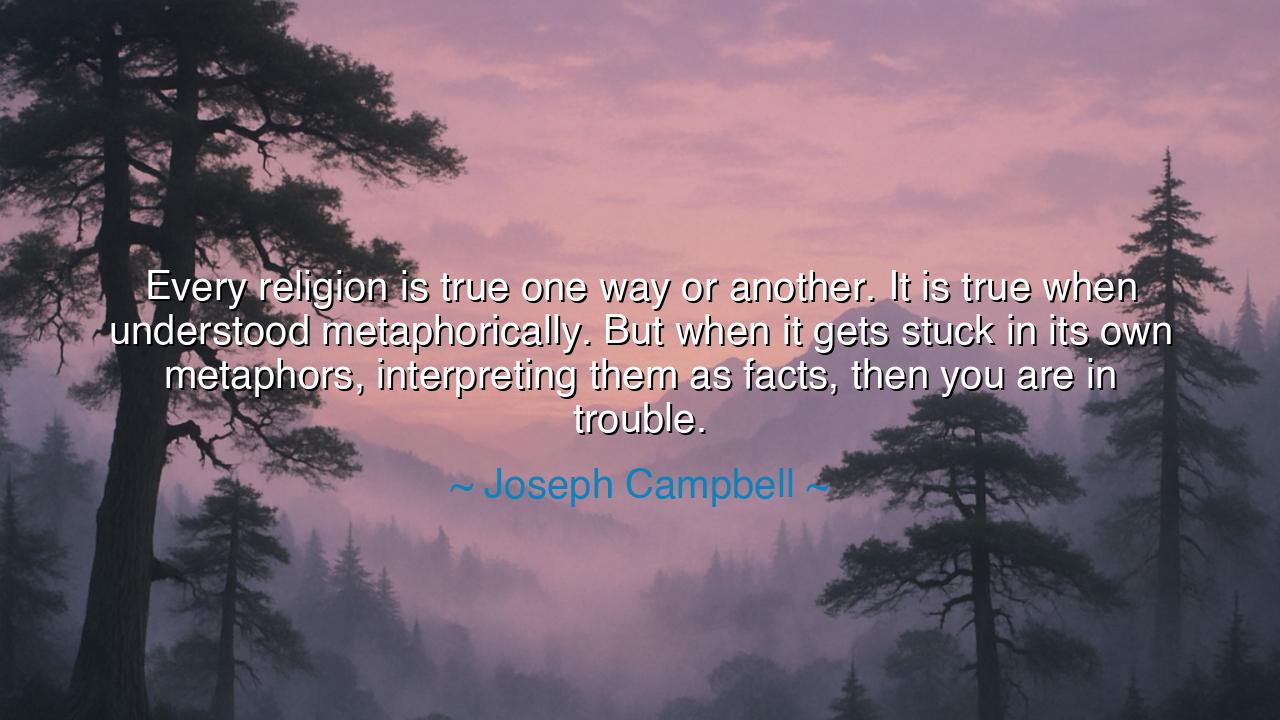
Every religion is true one way or another. It is true when
Every religion is true one way or another. It is true when understood metaphorically. But when it gets stuck in its own metaphors, interpreting them as facts, then you are in trouble.






"Every religion is true one way or another. It is true when understood metaphorically. But when it gets stuck in its own metaphors, interpreting them as facts, then you are in trouble." – Joseph Campbell.
In these words, Joseph Campbell offers a profound reflection on the nature of religion and its symbolic truth. He suggests that the core teachings of every religion hold truth, but this truth is often expressed through metaphor, a language of symbols that speaks to the deepest parts of the human experience. When religions hold their metaphors too literally, they risk losing sight of their deeper, universal meanings and instead become trapped in rigid interpretations. Campbell calls attention to how the myths and stories within religions serve to guide us, not as factual accounts, but as reflections of human truths—about the divine, about morality, and about our shared journey through life.
The ancients, too, understood the power of metaphor in religion. Plato, the Greek philosopher, famously told the story of the Allegory of the Cave, in which prisoners are trapped in a cave, seeing only shadows on the wall. For Plato, this story was not meant to be taken literally, but as a metaphor for the human condition: most people, he believed, live their lives seeing only shadows of truth, unable to grasp the deeper reality that lies beyond. In this sense, Plato recognized the danger of becoming stuck in literal interpretations of truth, urging instead that we look beyond the surface, beyond the metaphors, to the deeper reality they point to.
Similarly, the ancient Egyptians understood their gods and mythology as symbolic representations of universal principles, such as life, death, and rebirth. The great god Osiris, for example, was not worshiped as a literal ruler of the afterlife, but as a symbol of transformation and eternal renewal. Joseph Campbell, a scholar of mythology, pointed out how many religions speak to the same truths—sacrifice, resurrection, redemption—though they are framed through different stories. These stories, while unique in form, share an underlying message about the human experience. The danger arises when people begin to view these symbols as facts, rather than as expressions of human truths that transcend specific religious contexts.
The life of Jesus Christ offers another example of how metaphors in religion can hold profound meaning. Jesus' teachings are rich with symbolism, from the parable of the Good Samaritan to the symbol of the cross itself. Jesus did not come to preach a literal kingdom of heaven but to speak of the spiritual transformation that comes when one lives in alignment with divine love and compassion. The crucifixion and resurrection were metaphors for the cycle of death and rebirth that each individual undergoes in their spiritual journey. Yet, when these symbols are held too literally—such as viewing the death of Christ as simply a historical event—they risk missing the deeper spiritual message: that life is a cycle of suffering, transformation, and renewal.
Campbell’s insight about the dangers of taking metaphors literally can be seen in the fundamentalist movements that have emerged within many of the world’s religions. These movements, while rooted in the desire to preserve spiritual truth, often become fixated on the literal interpretation of religious texts, rejecting the symbolic meanings behind the stories. In doing so, they risk dividing people rather than uniting them in the shared truths of compassion, wisdom, and understanding. For instance, in the Abrahamic religions, the Creation Story in the Book of Genesis has been a point of contention. While the story of Adam and Eve has rich symbolic meaning about the human condition—the search for knowledge, the struggle between innocence and wisdom—many have taken it as a literal account, leading to conflict between science and faith.
The lesson from Campbell's words is a call to move beyond dogma and literalism, and to embrace the symbolic nature of our religious and philosophical stories. Metaphors are the language of the soul, designed to speak to us on a level that is beyond intellectual understanding. They touch on the deepest aspects of our existence, offering insights into the nature of life, death, and transformation. By understanding that religious teachings are often metaphors that point us toward greater truths, we open ourselves to a deeper, more universal wisdom that transcends the boundaries of specific religions and cultures.
In our own lives, we must learn to embrace the symbols in the religious, philosophical, and personal teachings that shape us. Instead of focusing on the literal interpretation of religious stories, we must look to the deeper truths they embody. By doing so, we can create a spiritual practice that is flexible, inclusive, and grounded in the universal values of compassion, love, and wisdom. Let us not get lost in the literalism of religion, but instead seek the deeper connection to the divine that is expressed in the symbols and metaphors that have guided humanity throughout the ages. Through this understanding, we find a spiritual path that connects us to all people, to all cultures, and to the divine truth that transcends our differences.






AAdministratorAdministrator
Welcome, honored guests. Please leave a comment, we will respond soon